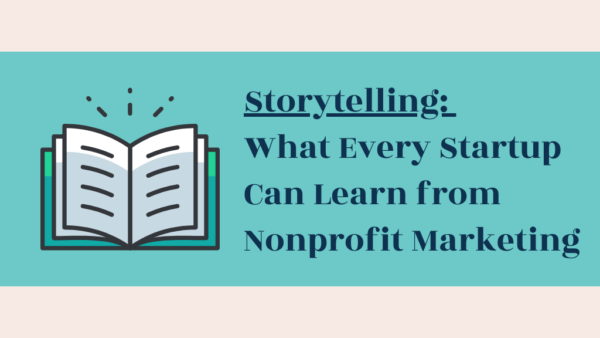
Marketing at a business and marketing at a nonprofit are two very different things.
Often I see content marketing strategies that work great for startups, recycled into blog content for ordinary nonprofits to follow. But that’s not always helpful.
Nonprofits don’t have sales teams to set up and manage elaborate funnels. Most nonprofits won’t have a dedicated marketing team to create and execute SEO-focused, content-marketing strategies. And most importantly, nonprofits aren’t going after customers. They need donors.
However, successful nonprofits have had to learn to do one thing exceptionally well – storytelling. They need to convey a complex reality that their mission aims to solve, and then communicate that to their audience. Doing that isn’t easy at all but central to nonprofit marketing. Nonprofit infographics, along with nonprofit video campaigns are great examples of compact storytelling that can be broken down and replicated.
Understanding how to tell stories is also very useful to startups. Storytelling is how you get more customers or clients. It’s also how you build your brand as an employer and learn to attract top talent. On top of that, nonprofits have had to master the art of storytelling with very limited resources – also relevant to many startups.
From time to time, you may come across examples of startups that did something innovative and then saw their revenue quadruple overnight. You want to try out something similar.
But those startups might have had very different resources at their disposal – capital and human. They may have secured a substantial amount of funding, and employed sales people, specialists, marketers and other role players focused on growing revenue. They may also be relying on SEO services and insights from consultants who provided solutions specific to that startup.
So if a nonprofit, with limited resources, is successfully engaging its target audiences through storytelling, it’s worth looking into.
Let’s take a look at a great example of nonprofit storytelling and break down what it does well.
Real Stories of Hunger: A Nonprofit Storytelling Example
Feeding America is a nonprofit organization that seeks to eliminate hunger through a network of food banks across the country. Real Stories of Hunger is an ongoing video series campaign that features actual stories of people whose lives intersect with food banks.
They have more recent videos under the campaign, but this particular one has gained almost one million views. It does a few things exceptionally well worth breaking down.
Check it out.
Let me take a moment to first break down the narrative, and then the visuals.
The Narrative
The narrative is great because it establishes a few things. First, that children going to school may be hungry, lacking the necessary energy and nutrients to learn effectively. This is a reality in America.
The second point it makes, through the narrator Lamont, is that working class families need this support structure. He relates his own experience relying on food banks. Although he was working, his circumstances changed quickly due to a work accident. The food bank provided that support, allowing him to bounce back. One day he even ends up as director at a food bank himself.
The food bank is a safety net that supports the economy. With food banks available in communities across the country, working class families do not slip into poverty and extended hardships. Instead, they are able to withstand difficult situations and continue contributing to the economy. It demonstrates that food banks actually work.
The Visuals
I think the visuals are particularly powerful. They show you snapshots of kids as Lamont describes his story of a child dealing with a lack of food. Then you see Lamont’s family, modest homes, features of what appears to be a small town, the American flag, candid takes of Lamont’s family happy, and then the food bank. So much is captured in just a handful of key shots. You understand that there are smaller, vulnerable communities that need these support systems in place. Without them they would fall apart, but with them they would continue to be homes to hard-working, American families.
Now how does this translate into an approach startups can take? The expectation isn’t that every startup somehow aligns with a social good and is constantly life-changing. Before I answer that, I’ll share one example of a saas brand that does it well, and then explain why it works so well.
Dropbox – A Startup Storytelling Example
When Dropbox got started about ten years ago, they created a very simple promo video that explained how the tool works. It was from the perspective of one ideal Dropbox user persona.
Take a look.
If we compare this video to Feeding America’s campaign video, they can be broken down in the following way.
Ordinary Life > Problem > Solution > Extraordinary Life
Josh represents a type of user Dropbox wants to appeal to. They use a very simple video (using cut outs and narration) to convey exactly what problem Dropbox solves.
The format is similar to Feeding America because there is a central character or type of person, a problem, and a solution that is impactful. Most importantly, it shows Dropbox has done their homework. They not only provide a solution to a general problem (file storage and accessibility), they understand the priorities of an individual and demonstrate how the tool integrates into their life.
Taken one step further, Josh would become a very specific professional with a particular job to be done (JTBD). Your startup would demonstrate how your product/service integrates into that professional’s work-life, making it easier and more productive. This straightforward approach demonstrates how well you know your audience, and how your product ties into the larger scope of the professionals priorities. While this works for marketing content, storytelling is key to creating an insightful customer journey map and other communications collateral.
These approaches to storytelling also help you develop a brand, which will be a key differentiating factor over time.
That’s the power of effective storytelling.
I used video content as examples, but how and where you tell a story is up to you. You can tell a story through webinars, presentations, infographics, landing pages, product demos, user calls – it’s entirely up to you. But understanding how to frame a story is essential. You can check out more nonprofit storytelling examples to get a better sense of constructing a narrative.
What do you think? Is storytelling overrated in marketing? Is it underrated? What are some great startup storytelling examples you’ve come across that are worth sharing? Let me know!
Business & Finance Articles on Business 2 Community
(62)







